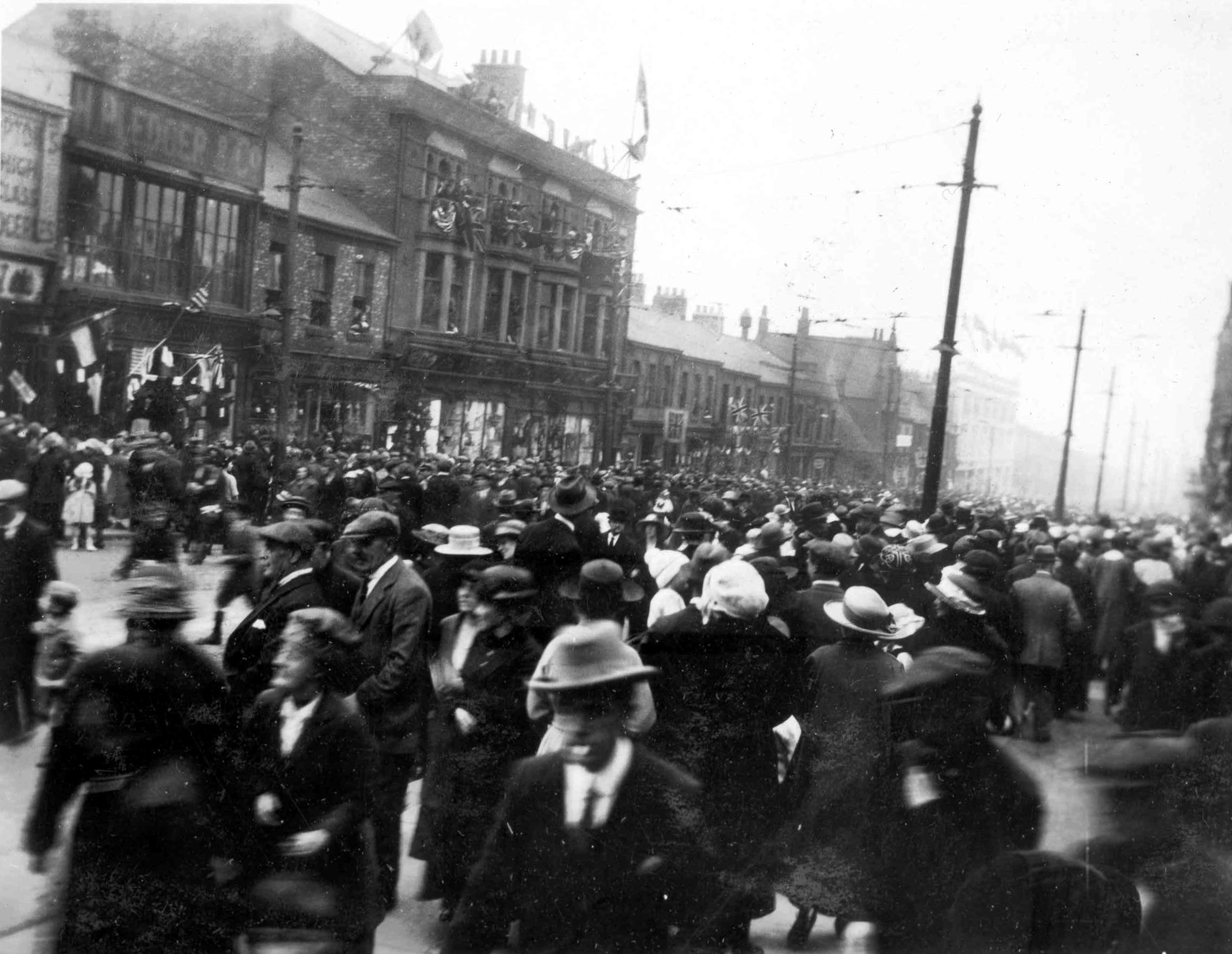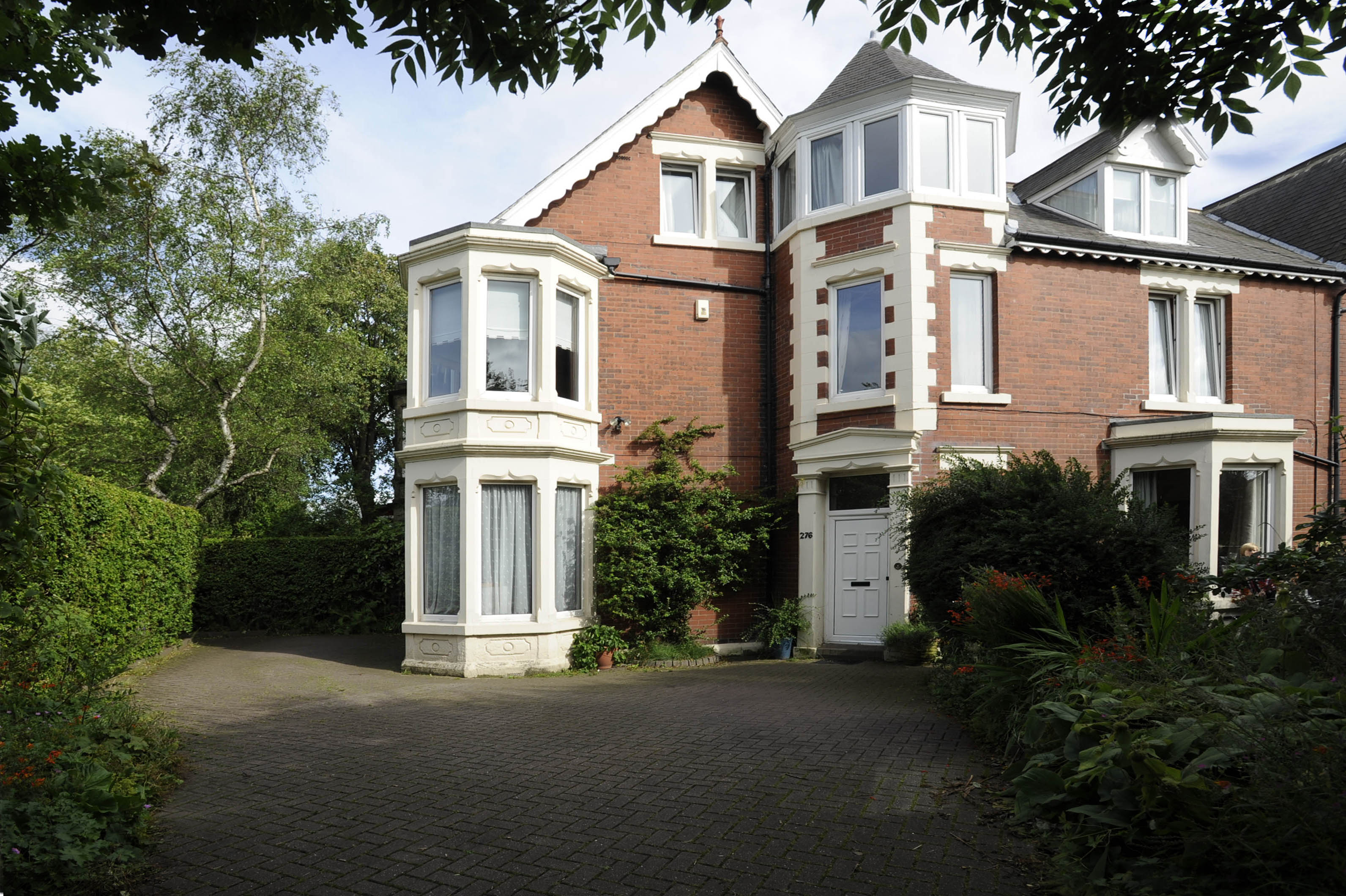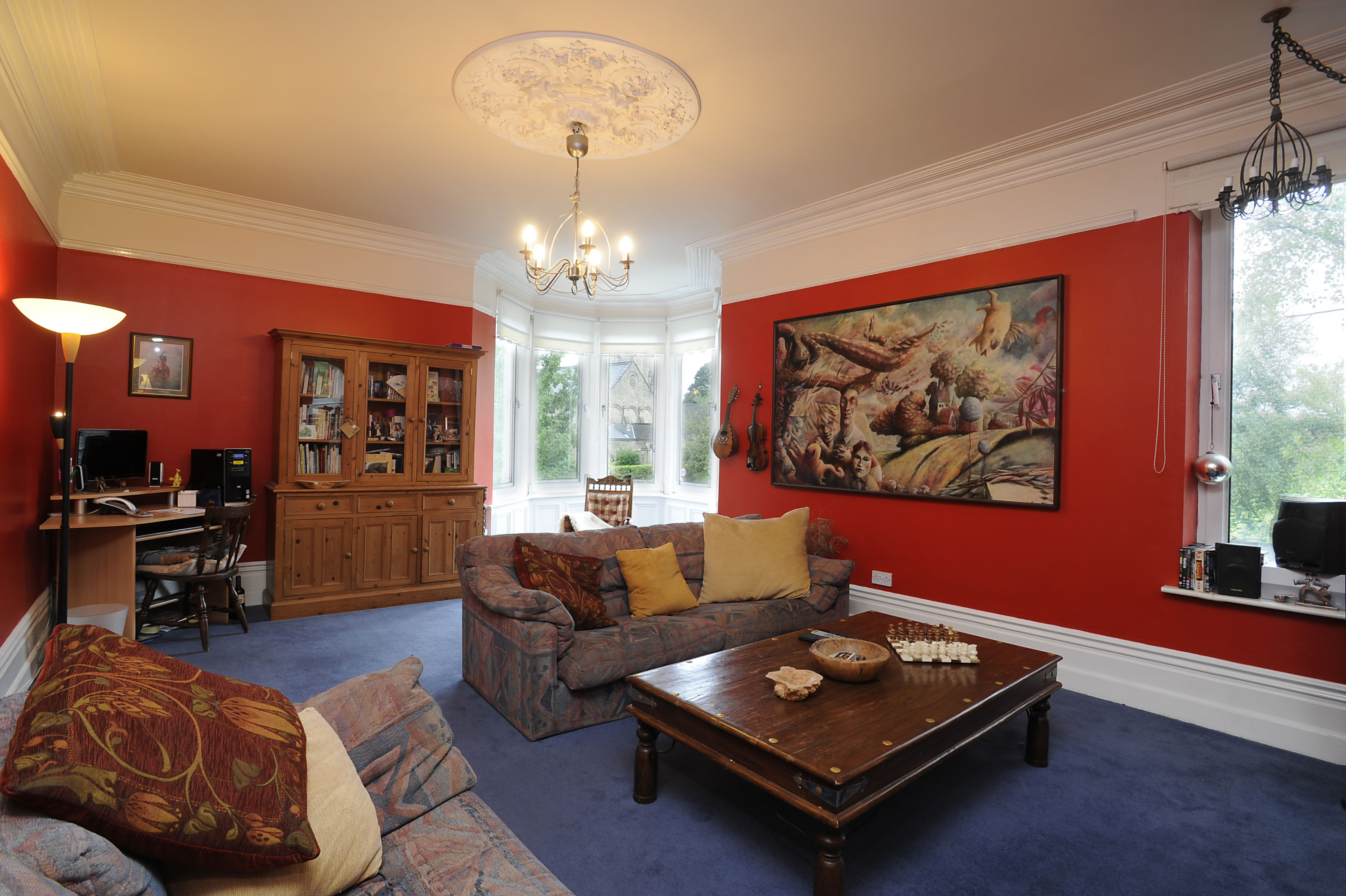‘Craigielea’ (276 Heaton Road) is an imposing early Edwardian brick villa situated on the corner of Heaton Road and Cartington Terrace opposite both St Gabriel’s church and the Heaton Medicals cricket and rugby ground. We were thrilled when just before recent owner Jimmy McAdam moved out, he invited us to look through the house’s deeds and other documents. What would they reveal? We suspected that some interesting people would have crossed its threshold and we weren’t disappointed.
The first question the documents answered was the age of the house. The first conveyance is dated 3 June 1902. It shows that William Watson Armstrong, who had inherited Lord Armstrong’s estate only eighteen months earlier, sold three adjoining plots of land, on what was termed the Heaton Park Villa Estate, to builder William Thompson of Simonside Terrace. The contract came with a myriad of strict provisos concerning the quality of the properties to be built on the site: only high quality materials were to be used; the roof and back offices were to be covered with Bangor or Duke of Westmoreland slate, yard fences were to be wire railings of approved design and four feet high; the front was to comprise a garden only; no trades were to be pursued from the properties etc. The high standard of design and workmanship is still evident today.
The architect’s family
William Thompson was the first owner of Craigielea but not its first resident. That honour seems to have gone to the Lish family. At least they are the first to be named in the annual trade directories. Joseph James Lish was born in Beamish, County Durham in 1841. By the time he moved to Heaton, he had been married for over 35 years to his wife, Nancy, a Londoner, and they had 5 children, the rather exotically named John Robertson, Kirkwood Hewat, Catherine Hozier Robertson, Bentley Beavons and Florence Meek. Sadly John, a Second Lieutenant in the Lincolnshire Regiment, was to die during the First World War. He is cited in De Ruvigny’s Roll of Honour which, in addition to giving details of his military service and heroic death, records that he was a shipbroker, coal exporter and all round sportsman.
His father, Joseph Lish, was an architect but he didn’t design the house or its two neighbouring properties. The original plans in Tyne and Wear Archive show that they were the work of the well-known Tyneside architects, William Hope and Joseph Charlton Maxwell.

Hope and Maxwell are remembered for their design of theatres, not only locally in Blyth and Newcastle, but as far afield as Glasgow, Margate and Southampton. Sadly the Hope and Maxwell theatres have all been demolished or been destroyed by fire. Another of their buildings does still stand, however, just up the road from Craigielea. It’s Heaton Methodist Church.
But back to Craigielea‘s first resident. There are a number of known Lish buildings around Tyneside, the most well known of which is the 1908 Dove Marine Laboratory, which still stands at Cullercoats. There is a book in Newcastle City Library in which Lish describes the design and build of the laboratory. He was an early advocate of reinforced concrete, using it in the Dove laboratory. What’s more, over a quarter of a century earlier, in 1874, he had exhibited his own invention, ‘Tilo-Concrete’. Lish was prominent in his profession both regionally and nationally. At one stage he was the President of the Society of Architects, whose Gold Medal he was awarded. He died in 1922 at the age of 80.
If you know more about Joseph Lish or any member of his family or have any photographs you are willing to share, we’d love to hear from you. Please get in touch either via the ‘Reply’ link just below the title of this article or by emailing chris.jackson@heatonhistorygroup.org
The marine engineer’s family
By 1911, the Lish family had left Heaton and marine engineer Robert Bales Armstrong and his wife, Margaret Emma, had moved in with their eight children and Robert’s sister, Sarah. Robert, from West Herrington in County Durham, was the son of a cartman/sheep farmer. His wife, from the same county, had worked as a Post Office assistant before she was married. By 1911, the two older boys, Frank Bales and Robert Hunter, were both apprentices in engineering and ship building respectively. The older girls, Sarah Jane and Daisy Bales ‘assisted with housework’; John, David Bales and Reginald Hugh were at school and Doris Hunter and Gladys May were under school age. The family also had a live-in servant, Annie Elizabeth Robinson. You can see why they needed a substantial house!

We are indebted to researchers of the Armstrong family tree who have posted on the Ancestry website for the above photo and additional information about Robert who had begun his career as a draughtsman at Hawthorn Leslie, worked for a while at Day, Summers and Co in Southampton and returned to the North East and Hawthorn Leslie in 1905. While living in Heaton, he was Chief Assistant to the Engineering Director and then General Manager. The family left Craigielea just before the end of the First World War. Robert was awarded the OBE in 1918 for his part in keeping the shipyards open during the war. Later he invented a steam powered boiler, the ‘Hawthorn-Armstrong’. Robert died in 1931 only weeks after becoming Managing Director of R & W Hawthorn, Leslie and Co Ltd.
The draper’s family
Next to move in to Craigielea was Herbert Pledger and his family. Herbert Pledger was born in Cambridgeshire, the son of a ‘bootmaker and publican’. By 1891, at the age of 22, he was a draper’s assistant in Saffron Walden, Essex and lodging with his employer. Within a few years, he had moved North and entered into a business partnership on Shields Road (See below). Soon he was to have his own firm.

We can track Herbert’s success by his various Heaton addresses. In 1895, he lodged at 29 Kingsley Place. By 1900 he was married, with a young son, and was householder at 105 Cardigan Terrace. In 1911, he, his Gateshead born wife, Annie and their children, Herbert Junior, William Cowley and Marjorie plus servant Isabella Caisley lived at 20 Simonside Terrace and for a couple of years from 1918, they lived at Craigielea before moving just up Heaton Road to Graceville.

Herbert Pledger Senior died in 1929 with an estate worth over £80,000, a significant fortune then.
Owner-occupiers
After the Pledgers moved out, the house was owned and occupied briefly by William Thompson, builder. This was the first time it had been owner-occupied and at present, we can only surmise that this is the same William Thompson who had built the house 20 years or so earlier. He seems also to have had a house in Coquet Terrace (number 39). Sadly he died soon after. Isabella , his widow, sold Craigielea in 1931 to William Thompson Hall, a doctor who also had a surgery at 12 Heaton Road. There is a document in which the freeholder’s lawyers say that (despite the original clause forbidding trades being practised from the house) they had no objection to Dr Hall’s medical practice and, subject to the approval of Lord Armstrong’s architects, a side entrance could be made for the convenience of Dr Hall. The plans are held by Tyne and Wear Archive.

Dr Hall died in 1934 at which point the house passed into the ownership of his widow, Edith, and an Isabel Dorothy Reed. From this point on, biographical information about the householders becomes a little harder to find but we do have the bare bones. From just before World War 2 until the late fifties, a Maurice Edward Robinson, manager, was in residence but didn’t own the property. In 1958 Vincent and Margaret Richards Fleet moved from 14 Coquet Terrace, paying Hall and ‘another’ £1,900. When Vincent Fleet died in 1977 the house was passed firstly to ‘Thomas and Spencer’ and then to the Taz Leisure group, which applied for, but was refused, permission to convert the house into the HQ of the Northumbrian branch of the Red Cross Society. It was then sold to Ronald and Philippa Oliver in 1985 (They had moved, as so many of the more recent owners had, from a nearby Heaton residence – in this case 18 Westwood Avenue.) The Olivers in turn sought planning permission, this time to use part of the ground floor for a tea room but this too was refused and the Olivers also soon sold the house. There were to be two further owners, ‘Maill and Grant’ and then Carol Simpson before Jimmy and Lesley McAdam of Tosson Terrace bought it in 1994 and lived there for over 20 years. Jimmy is a photographer and has a wealth of stories of his own to tell – but they’ll wait for another day!
Can you help?
If you know more about the history of Craigielea or any of the people mentioned, we’d love to hear from you. Please get in touch either via the ‘Reply’ link just below the title of this article or by emailing chris.jackson@heatonhistorygroup.org




Hi – I was really interested to read of the history of Craiglea as that it where my late mother Joy Balls lived for at least 3 years between 1959 and 1962 under the landlords Vincent and Margaret Richards Fleet who are referred to in the article. At the time she was teaching at Cambridge Street School in Scotswood having moved from her home in Essex. My late father used to visit her at Craiglea before they married hence the address on their wedding certificate being 276 Heaton Road. Regards Tim Hewitson
Thank you for getting in touch, Tim. It’s great to be able to add another detail to the history of Heaton and 276 Heaton Road, in particular. Chris (Secretary, Heaton History Group).
Simon Bainbridge emailed:
I’ve read your history of Craigielea with some interest. William Cowley Pledger was my grandfather. He joined his father’s drapery business along with his brother Herbert but he hated it and around the outbreak of WWII went to Newcastle University to read Agriculture and just after the war bought a farm at Cleasby, Darlington part of which is still in the family. My mother often talked of the business so it is fascinating to see the photos and learn of Bill’s childhood homes.
Received by email:
Hello
I’ve just found the Heaton History group article on Craigielea. I’m really interested in this as I’ve always wanted to go inside the house as it was built by my great grandfather William Thompson. My mum, Dorothy Gilhome, is now 96 and lived at Craigielea with her grandma and grandpa Isabella and William when she was quite young. The William Thompson you refer to that lived in the house was the original builder. She was born in 1923 and her parents separated and divorced when she was really young. She was then brought up by her grandparents Isabella and William. Dorothy remembers being in the turret room and having a great view across to the town moor. She could see the Hoppings and was taken there by their live in maid Elsie (from Ashington). Dorothy also remembers her dad and grandad having a big car – her dad would drive down to London from Craigilea in the 1920s flappers time. Dorothy has always remembered the house with fondness. She still talks about it now. I have pictures of William Thompson and of Isabella which I could copy when I am next in Newcastle.
Thank you so much for writing about the house.
Jill Gilhome
It’s lovely to learn more and hear more memories of Craigielea. Thank you very much. Chris, Secretary, Heaton History Group
Received by email:
I loved reading about the history of our old house where we lived in the 80’s. We bought the house from the leisure group and spent a year renovating it, it was a beautiful house and I remember the turret room so well. Unfortunately my husband had to work away a lot so we decided to move to Manchester and the house was sold. Happy to report we returned back to the North East…
Thank you again for mentioning us in the History of our past home, Ron and I were both from Heaton so are proud to be part of its history and hearing about all the previous and present owners.
Kind Regards Philippa Oliver
Hello,
Do you happen to know what the archive reference number is for these plans? I’ve been trying to do some research on J.C. Maxwell but have had a tricky time finding any archival material related to him. A quick search of the Tyne and Wear archives brings up a record for Craigielea and Lyndhurst but this is associated with with architects Wood and Oakley and seems a bit late (1930s). Would love to know more about the records that were studied for this post!
Many thanks,
Rachel
Hi Rachel, Much of our source material was documentation held by the owners at the time with the deeds of the house. However, Tyne and Wear Archives holds a lot of building plans, which do not appear in their online catalogue. There is a series of drawers in the search room which is arranged alphabetically by street name. I am pretty sure they included plans for Craigielea. Chris